Play on, Y/N?
>>Y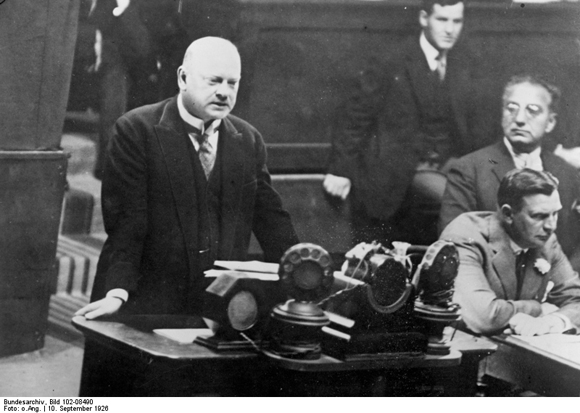 "Stresemann found himself facing a multifaceted problem: how to consolidate the
"Stresemann found himself facing a multifaceted problem: how to consolidate the Kerneuropa's
fragile framework, while securing Germany's leading role. How to eliminate or best integrate the last remains of the noble sympathisers' camp and the von Papen supporters to the Imperialist faction."
"How to ensure that the wars of the past could not threatedn Germany's future."
"In this he was forced to face the inopportune timing of Oswald Mosley's rise to power in Great Britain and the resulting influx of political refugees; the spectre of von Papen in Britain; the Falklands crisis. And, above all, his own failing constitution."Olga Müller 1996, The expansion of the Kerneuropa: in the shadow of the Paris Accords, Mainz: von Zabern.
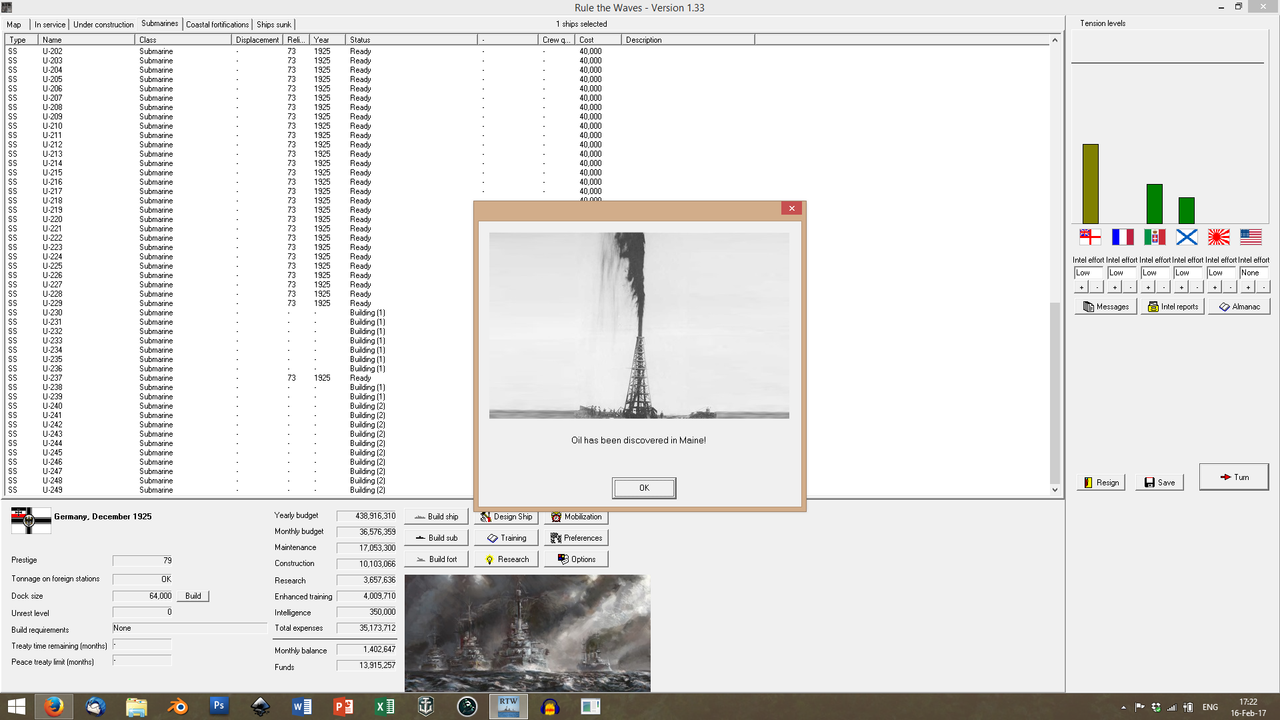
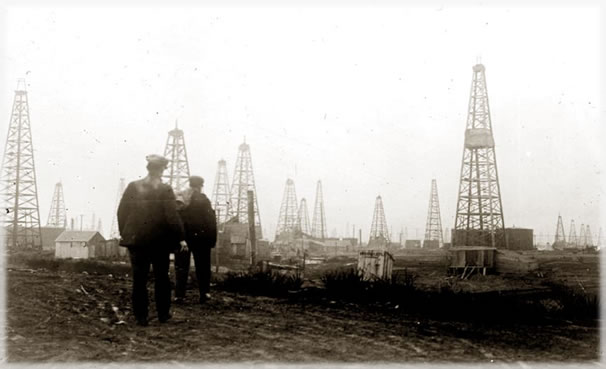
January 1926: Distant news reach Europe of new American oil-fields in Maine. This has no direct impact on Stresemann's policies, although it does affect the price of German oil. America, at this point, is simply too isolationist to significantly affect the goings-on in Europe.

What
did affect things in the European theatre was the proposal by Blohm & Voss to take up a third ship of the
Hannover class at a reduced price.
The
Hannover and
Hessen had been considerably delayed: work on the former had resumed after a considerable hiatus, while construction of the latter was still frozen. But the work on
Hannover had proceeded sufficiently for the yards to figure out substantial shortcuts and fixes that could reduce the price of a third ship. As the
Admiralität was eager to help boost the German economy further, the proposed laying down of a third ship (the
Wörth) was approved. Her keel was laid down on the 4th of January.
This apparent rearmament of Germany, in the wake of her recent
disarmaments received mixed responses.
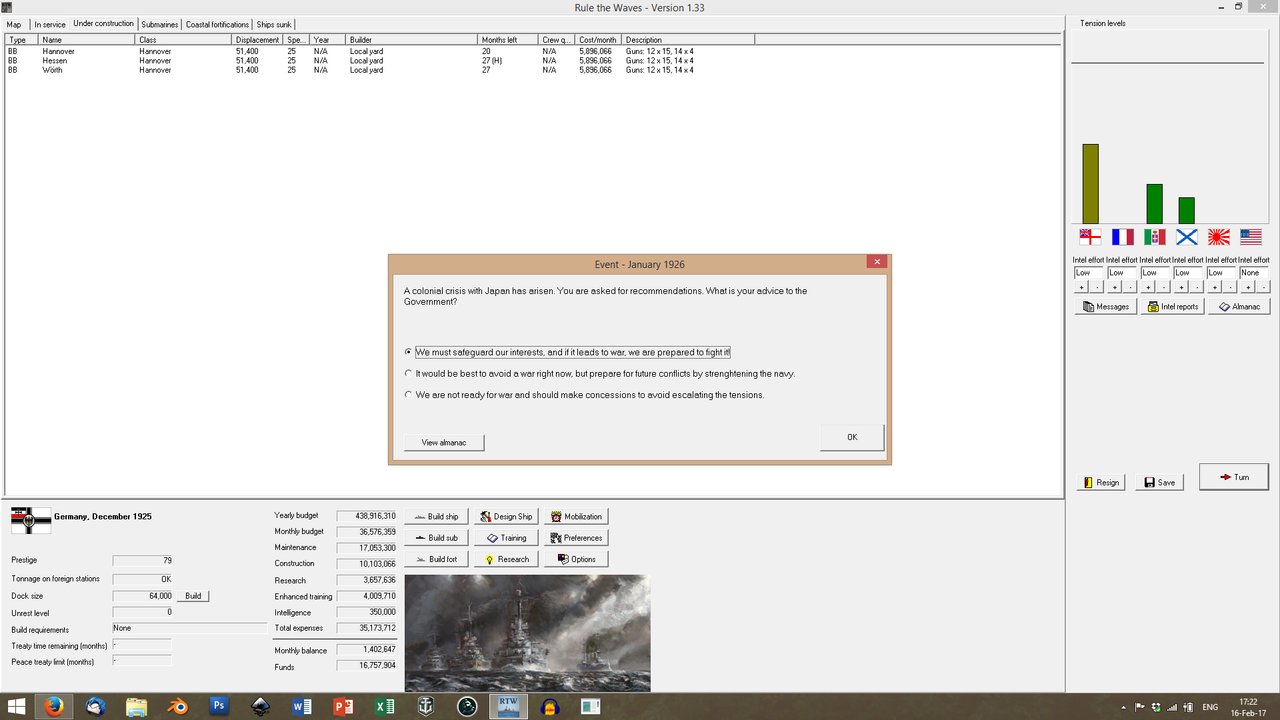
Japan, for one, protested vehemently at what they perceived as new escalation; and as an attempt by Germany to project more force in her colontial holdings. The
Admiralität refused to budge, and Stresemann was forced to adopt a more inflexible stance than he would have liked, especially since his hands were full in Europe.

But the
Admiralität's attention was firmly on what they perceived to be more important matters. For, on the 23rd of January, the first designs for a new, revolutionary new submarine class were submitted.
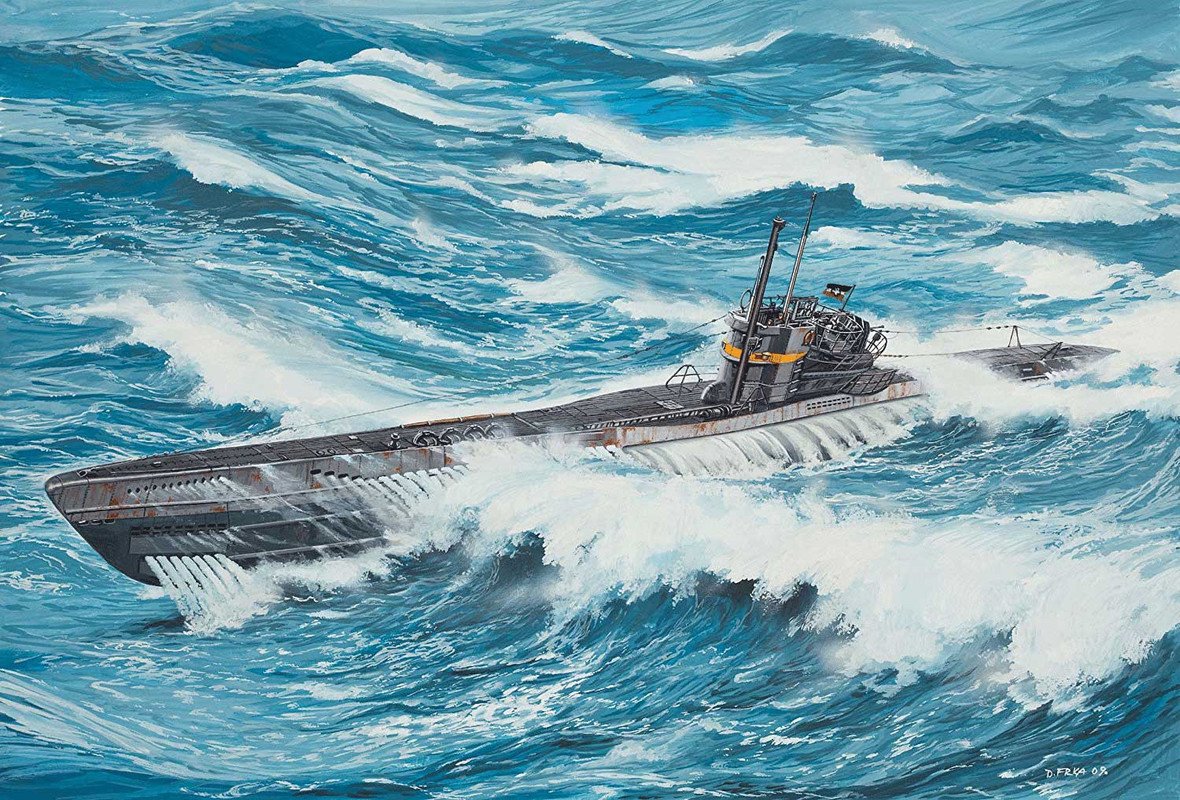
The
U-255-class bore a reduced torpedo armament, compared to the more 'traditional' attack subs; but they had the same range and speed, while also carrying a considerable number of mines. This made them much more flexible on the field, and a much more significant threat against convoys moving through pre-planned routes. They would never completely replace the awesome striking power that were the German attack
U-Boote, but the minelayers would prove their worth a hundred times over during the following years.
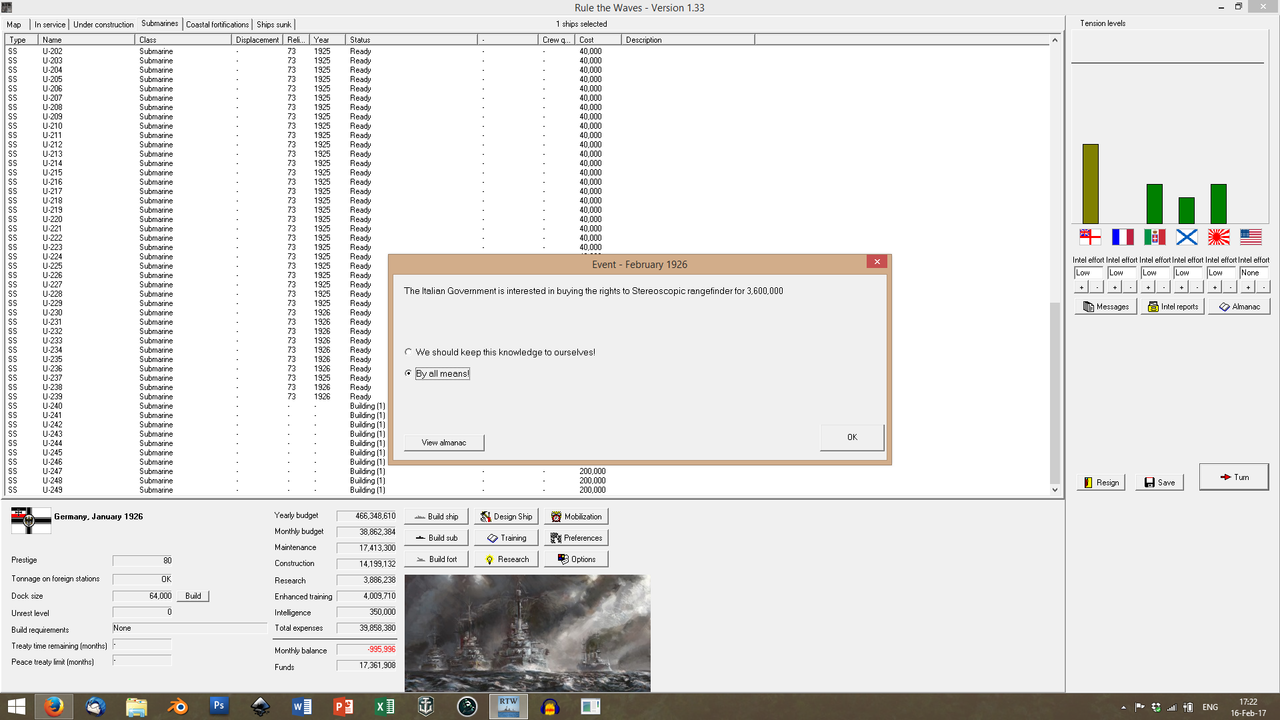
Meanwhile the Italians approached the
Admiralität with a proposal: they wished to purchase German licences for the high-quality stereoscopic rangefinders used in German capital ships. Galster and Sheer, both veterans of the Italian war, had no objections. Italy was no threat: in fact, tensions with the Spaghettis were quite low and fostering good relations with the Mediterranean neighbours had the full support of Stresemann.
The licences were sold, for a very satisfactory three-and-a-half million
Reichsmark.
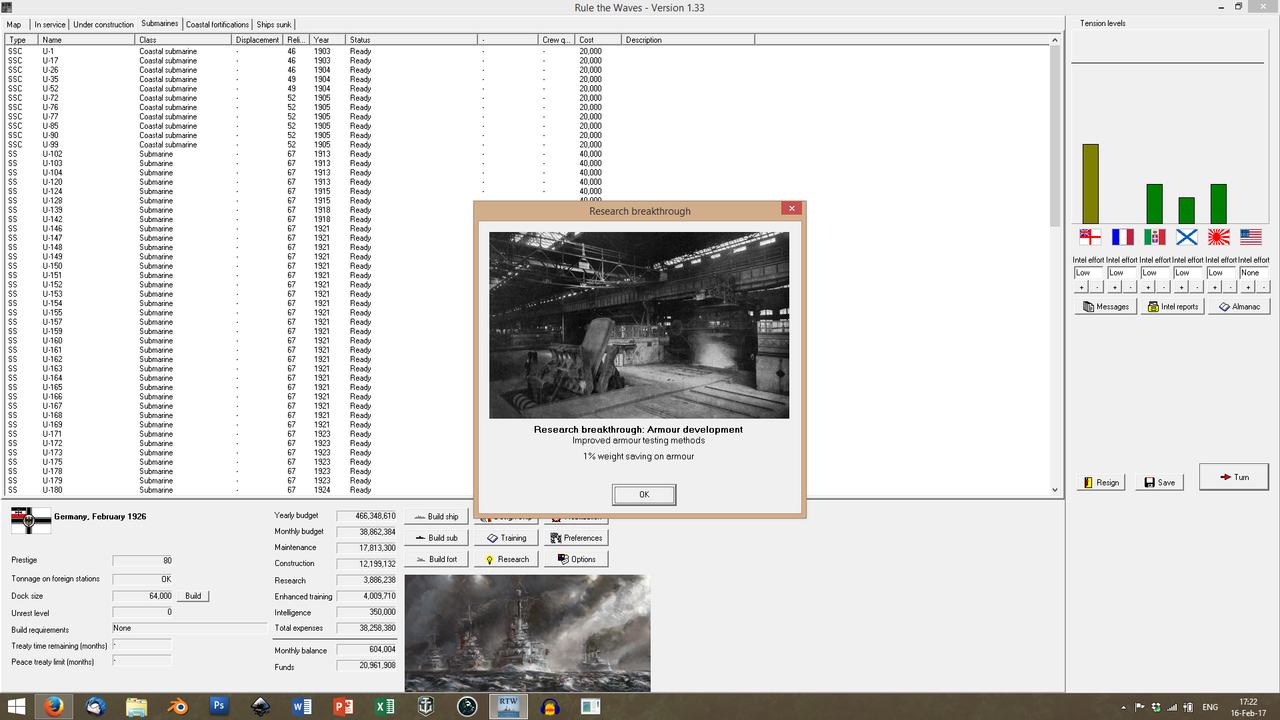
In February, and with the first armour sheets being about to be installed on
Hannover Scheer focused his attention to establishing a rigorous series of tests. Several engineers, both military and civilan, were called upon to test the armour under as close to field conditions as possible, including live-fire exercises. This helped reveal further unoptimised elements in the
Hannover design, elements that could now be ironed out.
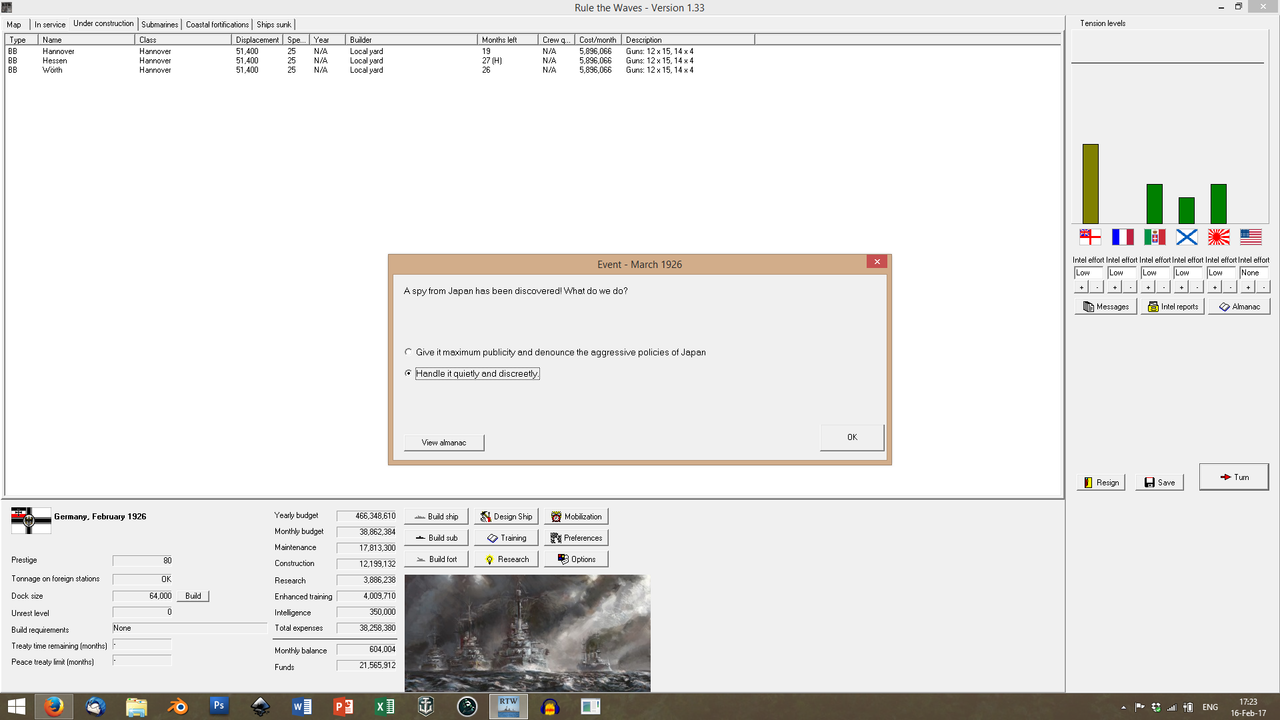
Unfortunately, one of the engineers running the tests proved to be more corruptible than expected. Military Intelligence managed to prevent the results of the tests finding their way to the hands of the Japanese, but the danger of further escalation in the Far East was now very real. Unlike von Papen, however, Stresemann knew not to ask for trouble. This time, Germany would look the other way.
Pointedly.

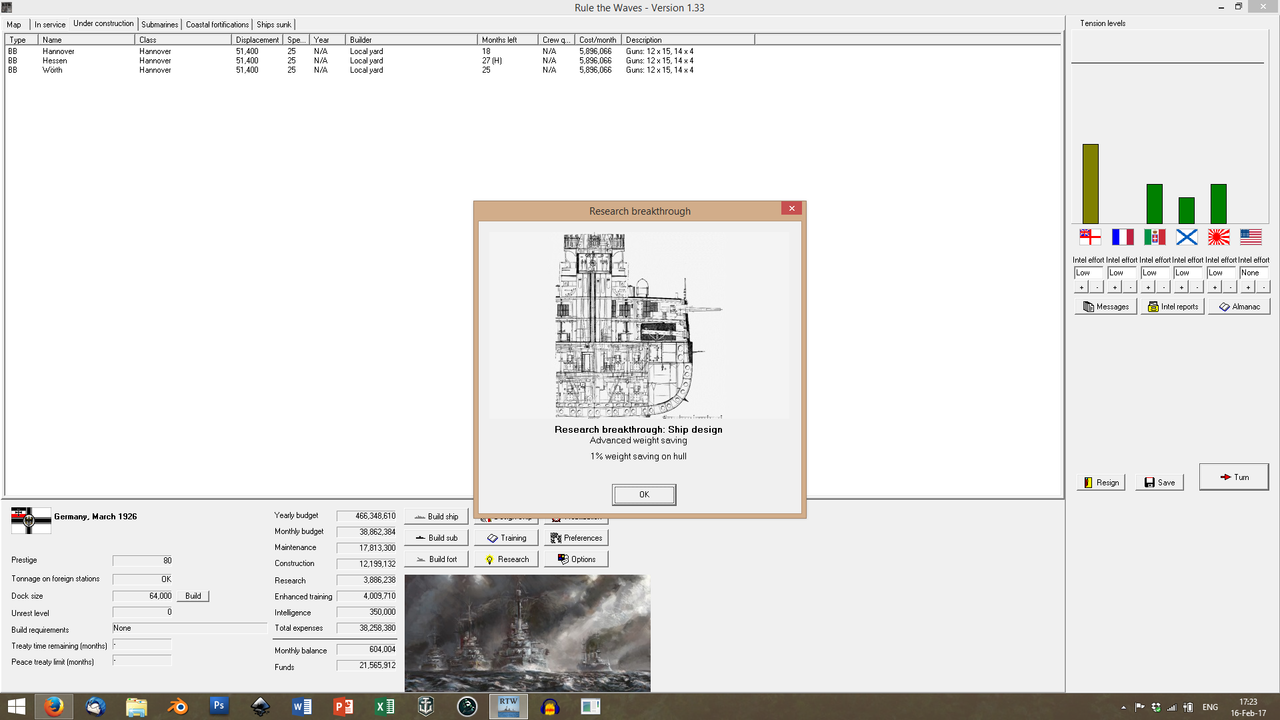
And the tests continued. A study on fire prevention and armour resistance against high-explosive and white-phosphorus shells led to the introduction of new, non-flammable paints and coatings. Furthermore, a structural analysis of the
Hannovers' hulls helped to better integrate the internal belt to the hull framing.
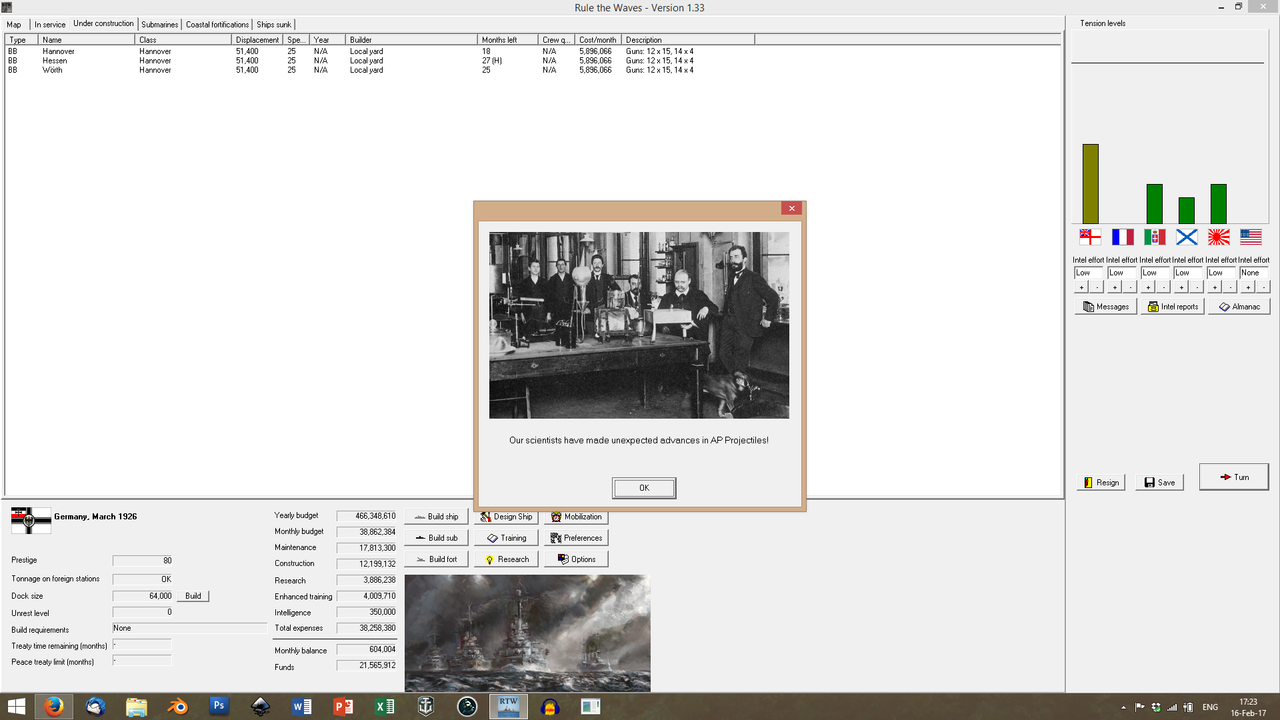
And, when you're studying armour, you're also studying ways to
pierce it. R & D promised that they were really close to introducing a new generation of armour-piercing projectiles. Not yet, though, not yet.
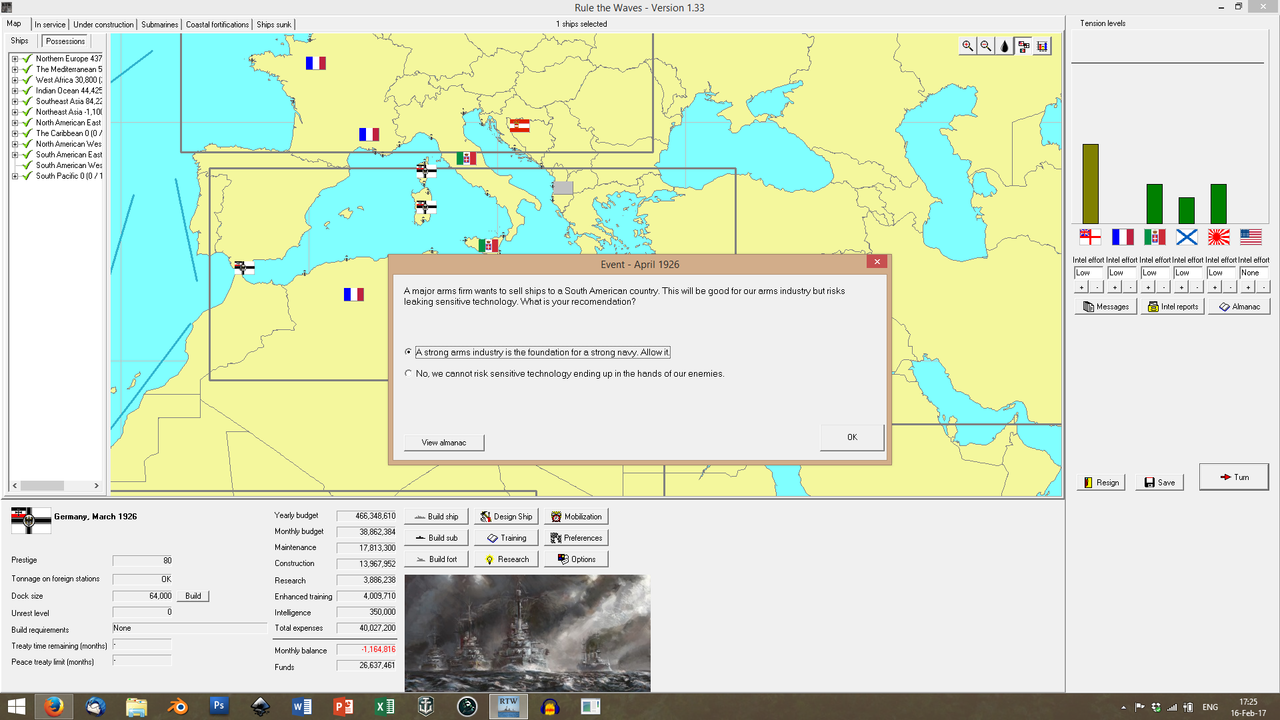
As March gave way to April, Argentina approached Krupp with what was probably the largest non-German contract the firm had ever received: The Argentinians were entering a major re-armament phase, which included a full modernisation of their field artillery, as well as the commissioning of two new 15'' dreadnoughts: the
Rivadavia and the
Moreno. They desired a competitive but economic dreadnought class, comparable in armament (but with lighter armour, and with a speed of only 23 knots) to the
Hannovers. This would make Argentina the strongest naval power in South America. Would Germany be interested in taking up the contract?
Krupp, in conjunction with Blohm & Voss, went directly to the
Admiralität, for their permission; Scheer and Galster, in turn, went straight to Stresemann, who approved of the plan. It was imperative to reinforce the Germany economy and this contract was worth hundreds of millions for the large companies and for the dockyard workers of the German harbours, who had suffered through something of a dry spell, in recent years.
Unfortunately, not everybody appreciated his concerns. And while the international scene failed, at the time, to register the importance of this agreement, it would come to haunt Germany in the near future.
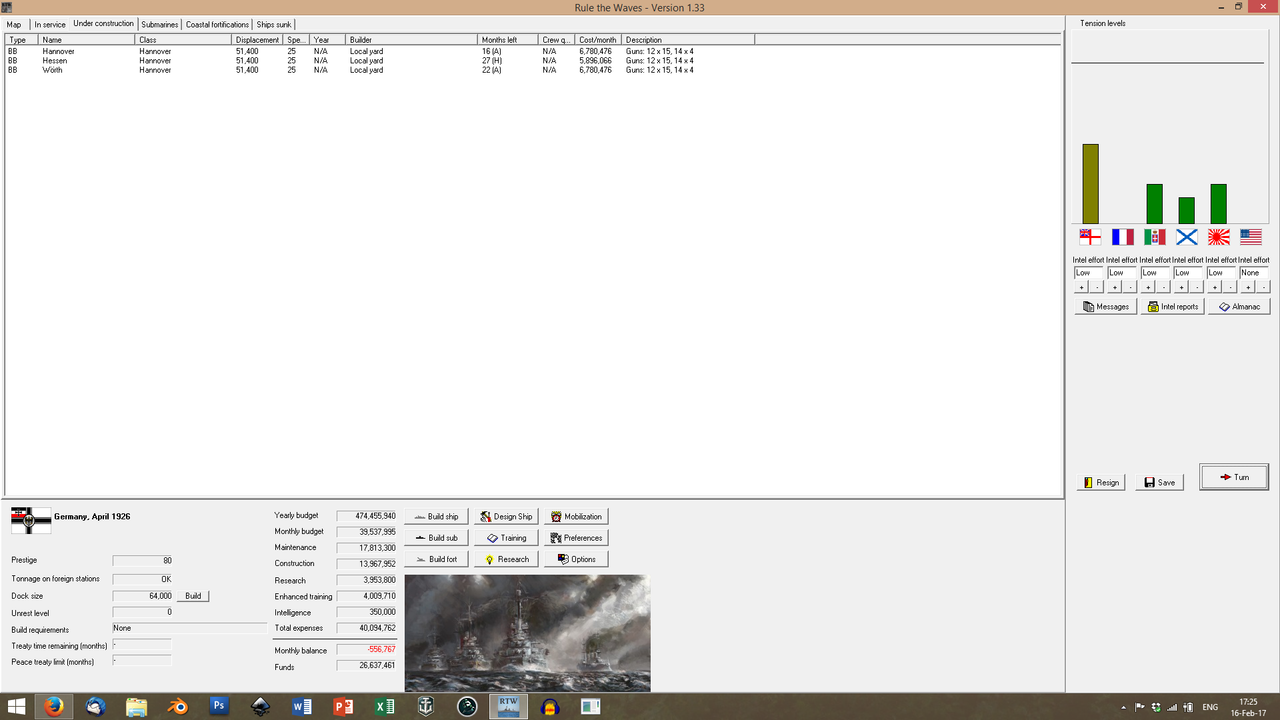
For the time being, with
Hessen frozen,
Hannover and
Wörth entered a phase of accellerated construction. Upon their completion, work would continue on their sister-ship.
Hannover was slated for completion by August of 1927.
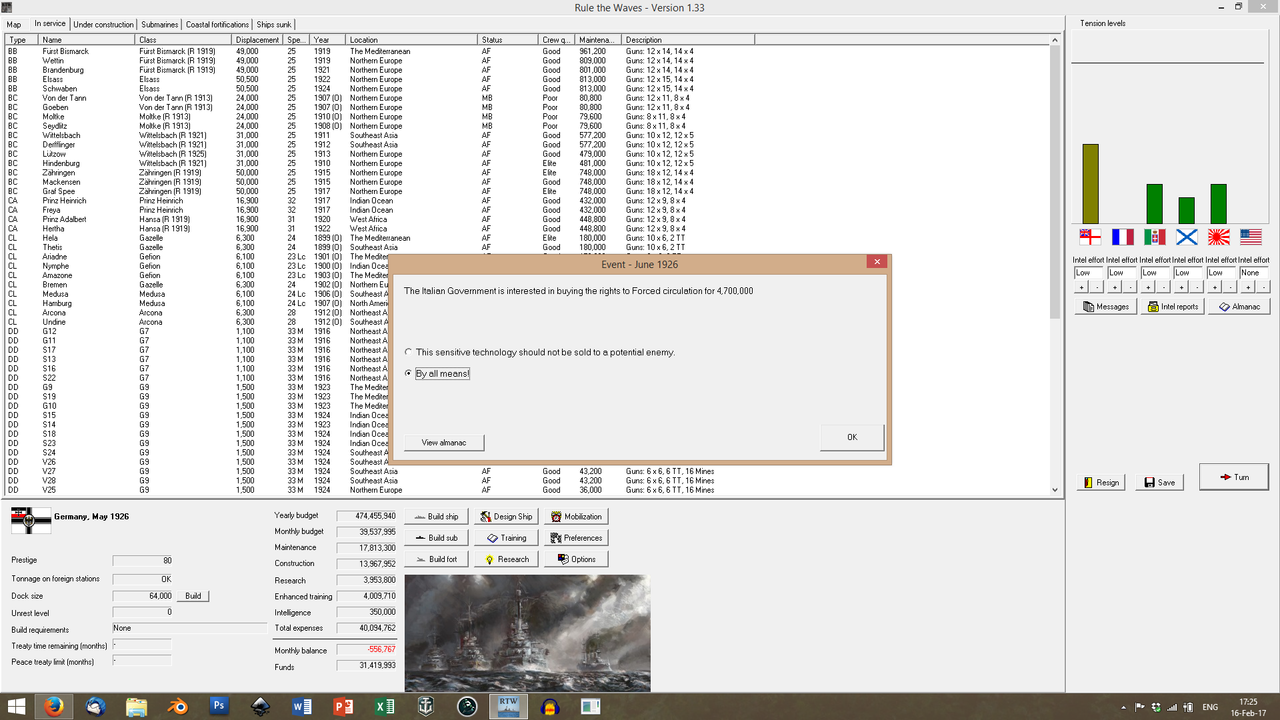
This accellerated construction was fuelled even further by the sale of engine designs to the Italians...
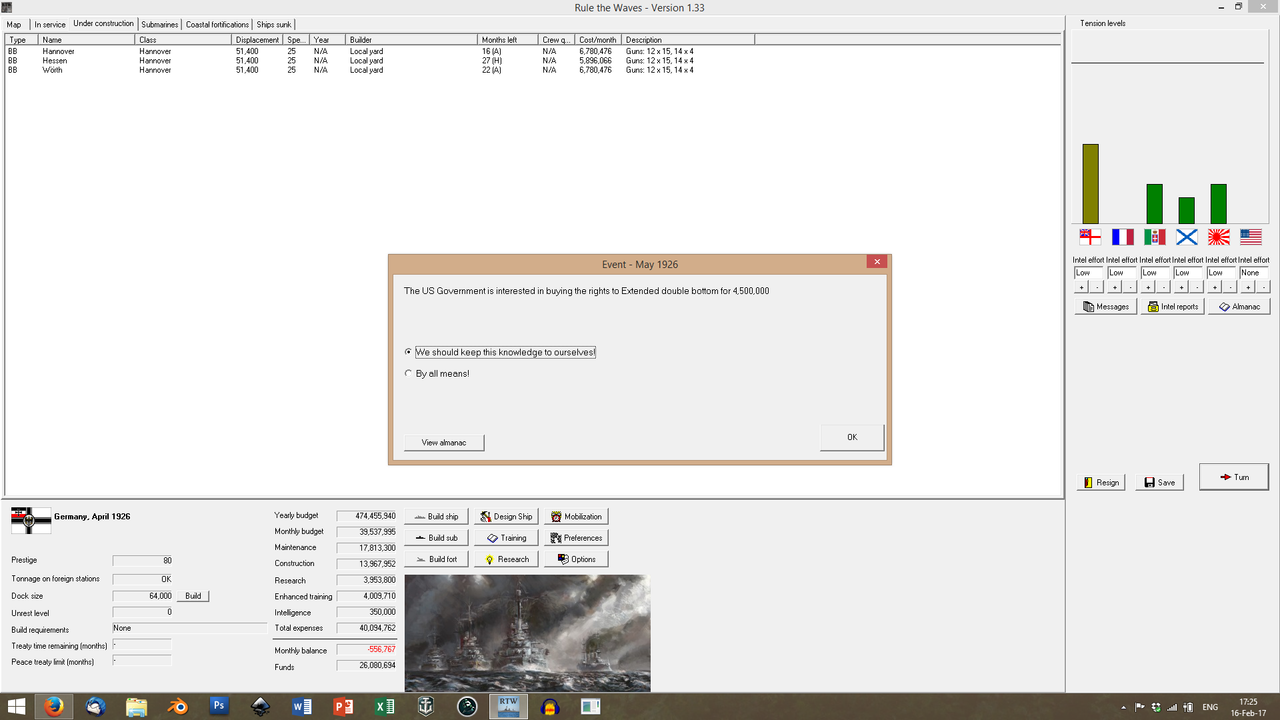
...but the
Admiralität vetoed the sale of triple-bottom designs to the Americans. At this point, Galster and Scheer believed they had sufficient funds for their immediate needs; and, while flirting with the Italians was politically desirable, reinforcing the American fleet was not.

Meanwhile, the
Hela was recalled for decommissioning and scrapping; the infinitely more powerful
Bismarck was deployed in the Mediterranean to replace her.
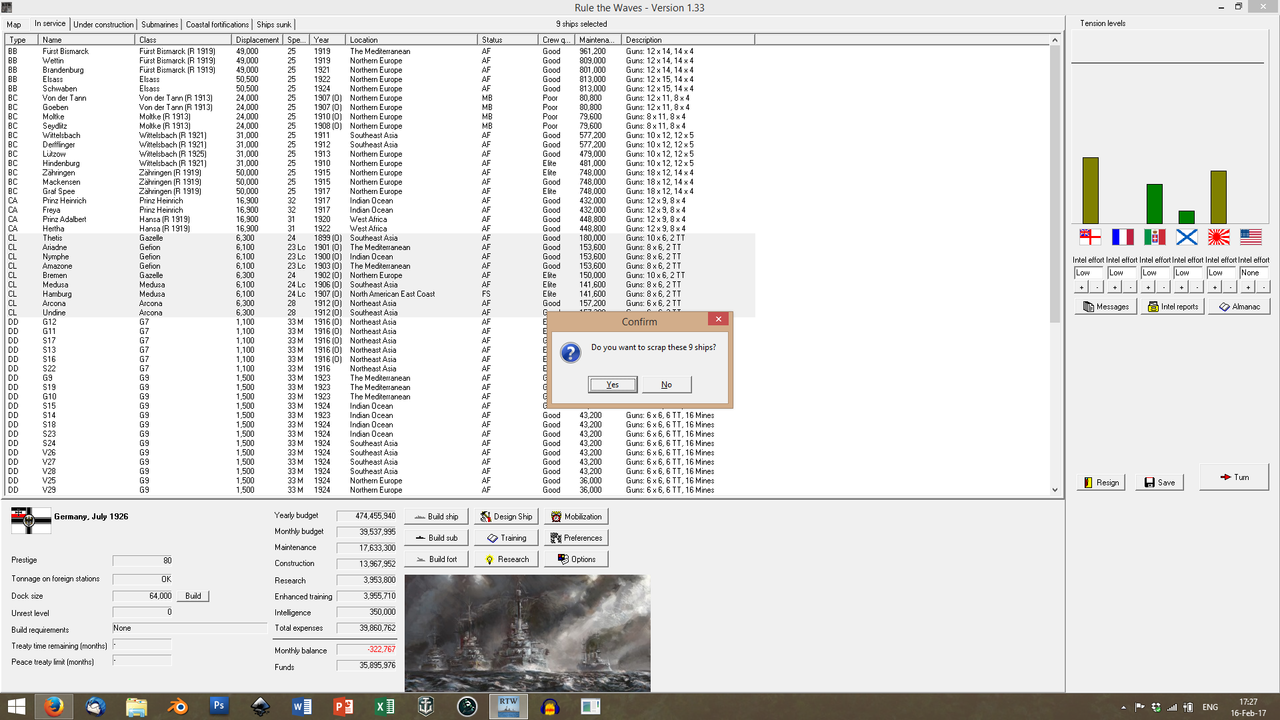
The
Admiralität did not stop there. By the end of July 1926, every single surviving
Gazelle,
Gefion,
Medusa and
Arcona were recalled and scrapped. Overnight, Germany's light cruiser force was no more.

This also meant the scrapping of old
Bremen, one of the pluckiest, more decorated and celebrated light cruisers in history. She had been a veteran of every war Germany had fought in the 20th century; she had bloodied the noses of the Russians, the Italians, the British, the French; she had wreathed herself in more glory than any other light cruiser, with the possible exception of her long-lost sister,
Frauenlob. Sadly, though, this time, the
Admiralität really did not have the funds to maintain her. She entered the breakers on the 25th of July, bringing an end to her legend.

Goodnight, little darling. Go now, to meet your sister.
.....
.....
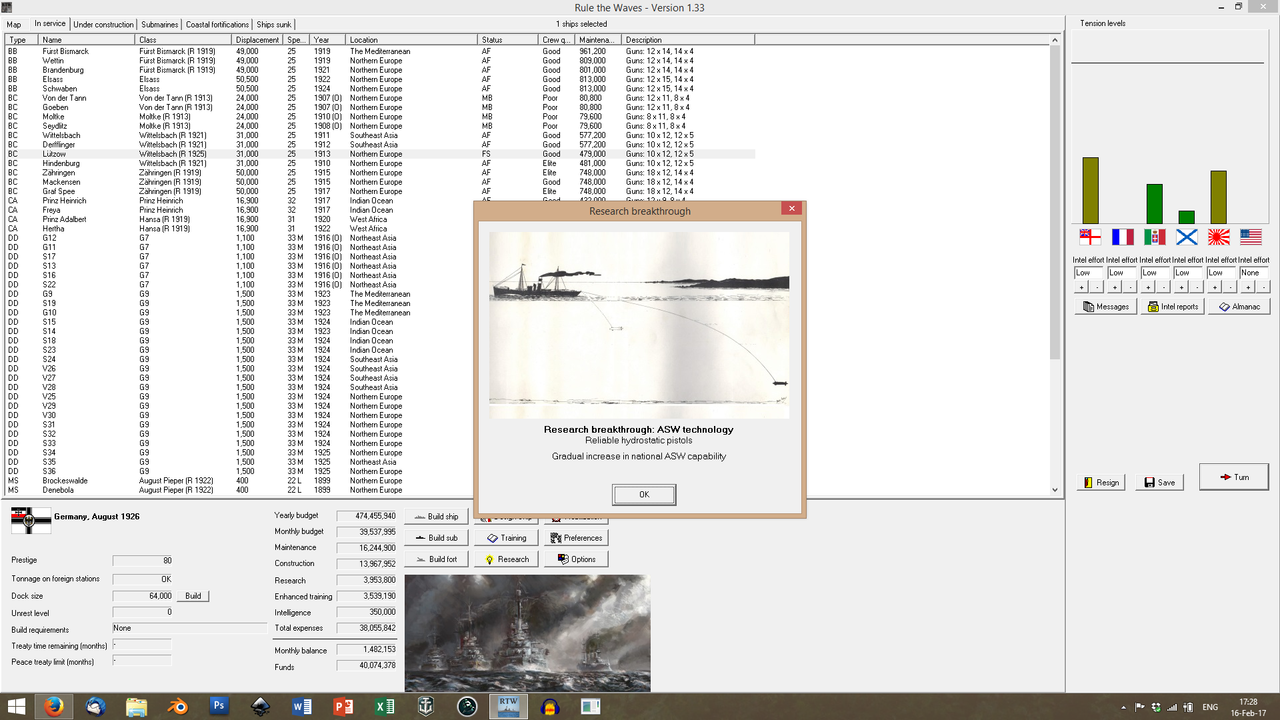
Right when things were getting a bit morose, R & D delivers with a new batch of ASW goodness...
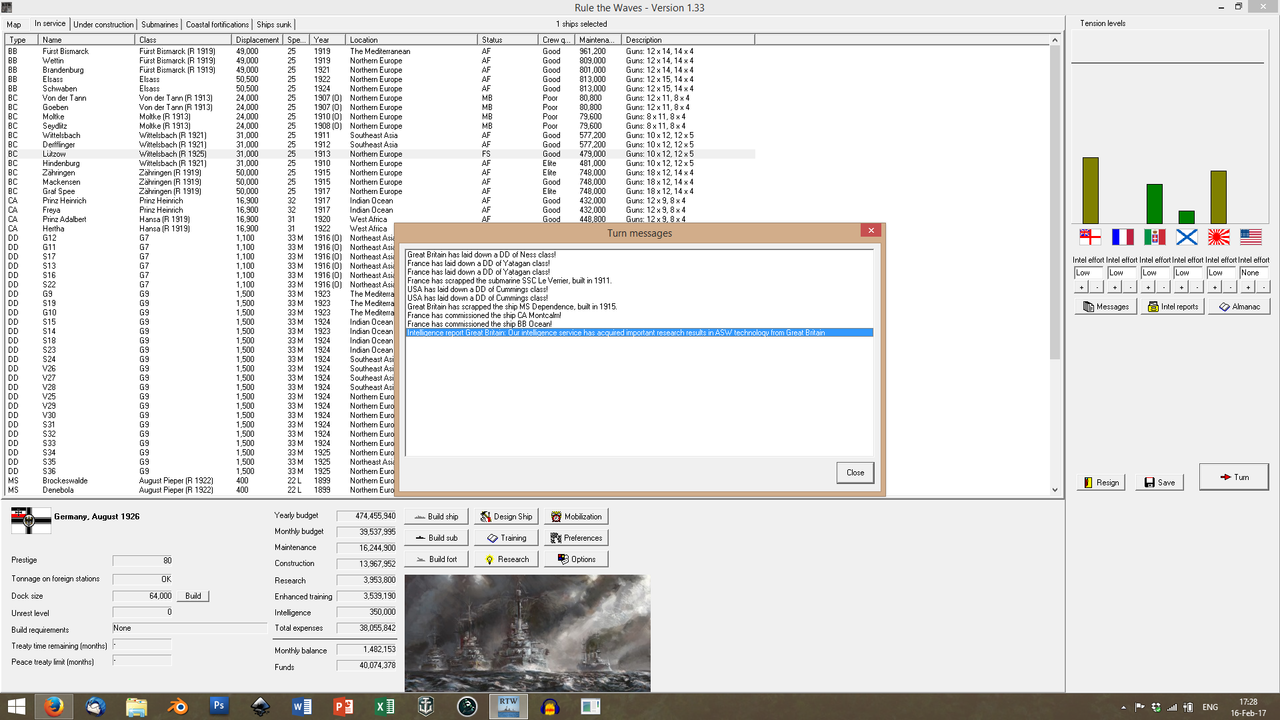
...that, turns out, was 'acquired' from the British. Lulz.
A propos British, let us see where we are in respect to...
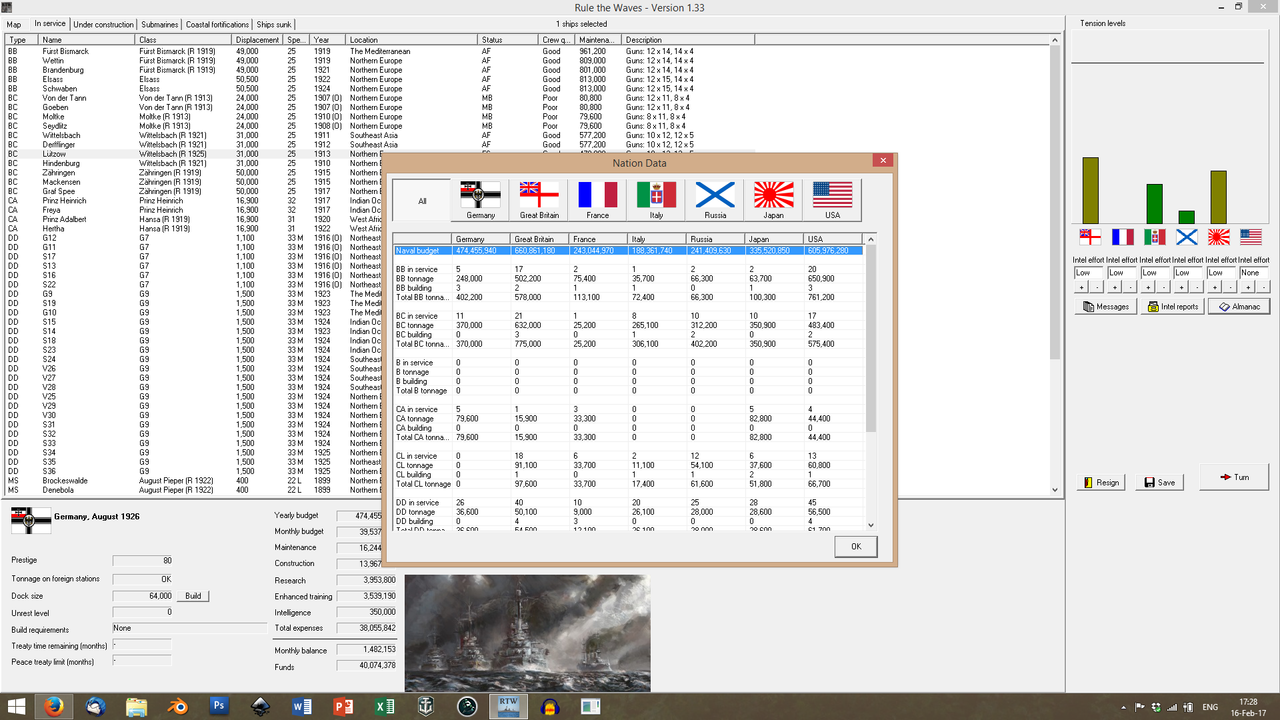
Urgle.
A quick consultation of the most recent fleet gazzetteers shows that Great Britain can field
seventeen dreadnoughts to Germany's
five. She also has
twenty-one battlecruisers to Germany's
eleven (and we are
still counting the Valkyries among those eleven). Great Britain has more than
twice the German tonnage afloat, both in Dreads and BCs.
The less said about the utter insanity that is the USN, the better.
Germany is one of the world leaders in heavy cruisers (surprisingly,
Japan has heavier ships!), but has no light cruisers at all. And her destroyers, while capable, are less than half in number when compared to the Brits and 'Muricans.
In less than a decade since her defeat, Albion has rebuilt her fleets.
It's a rude awakening for Stresemann and for the
Admiralität.
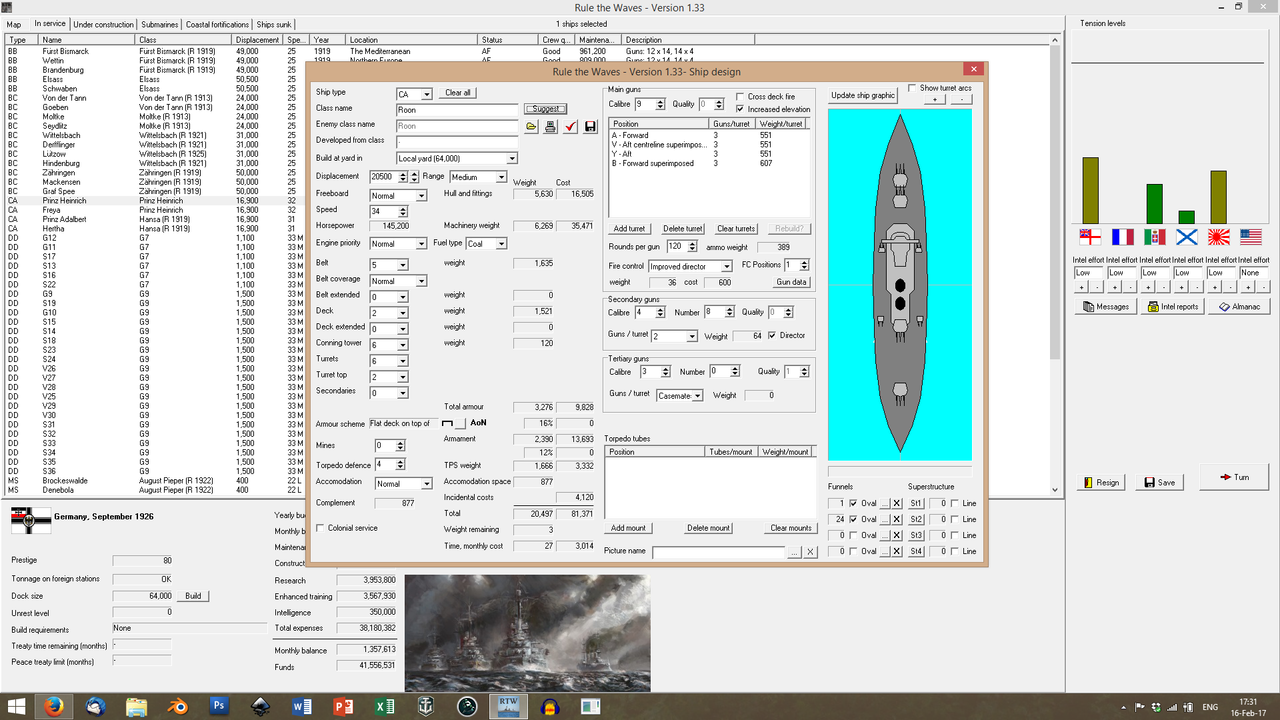
A proposed response: a better cruiser, that will cement Germany's advantage in the heavy cruiser field. At 20k tons, she's the biggest and baddest ever put to paper. She's armed with the usual 12 x 9'' arrangement, but has the most advanced torpedo protection system ever put on a cruiser, mounts turrets with 6 inches of armour instead of the 3 inches of her preddecessors and, more importantly, can reach 34 knots. This thing can outrun destroyers.
Her proposed name is
Roon and she's an absolute beast. She's also much too expensive, costing almost as much as a new
Schlachtkreuzer; and the designs are shelved for now, until the completion of the
Hannovers.
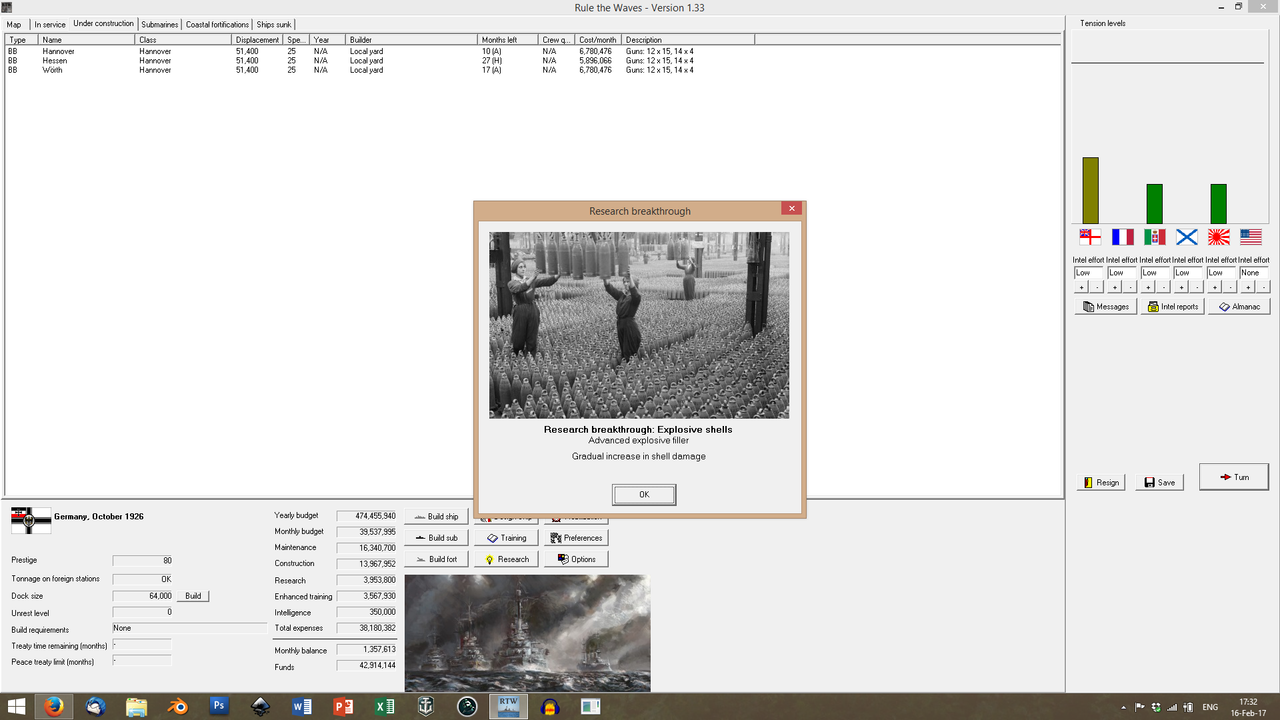
Better explosive compounds are put into production in October: they are routed primarily to the
Zerstörer flotillas.
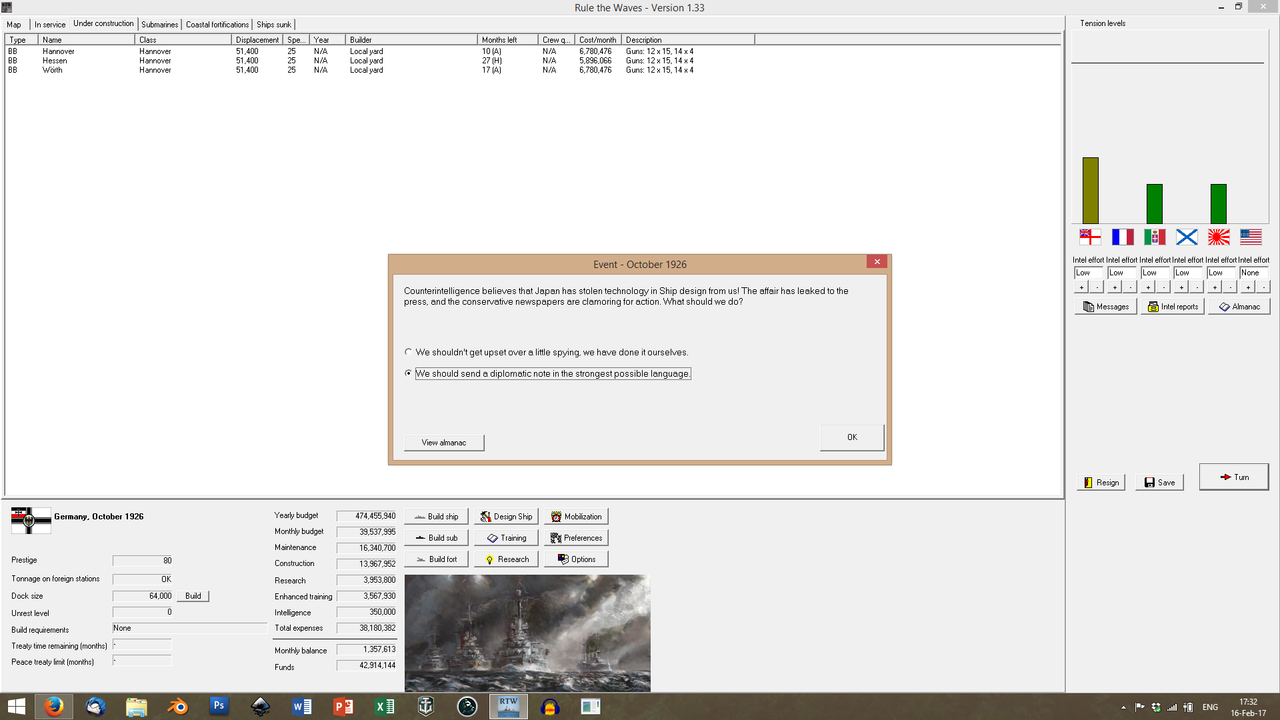
Japan once again tries to infiltrate the Argentinian warship slipways and are rebuffed; this time, Stresemann does not mince his words. Perhaps this time the Japanese will
get the point.
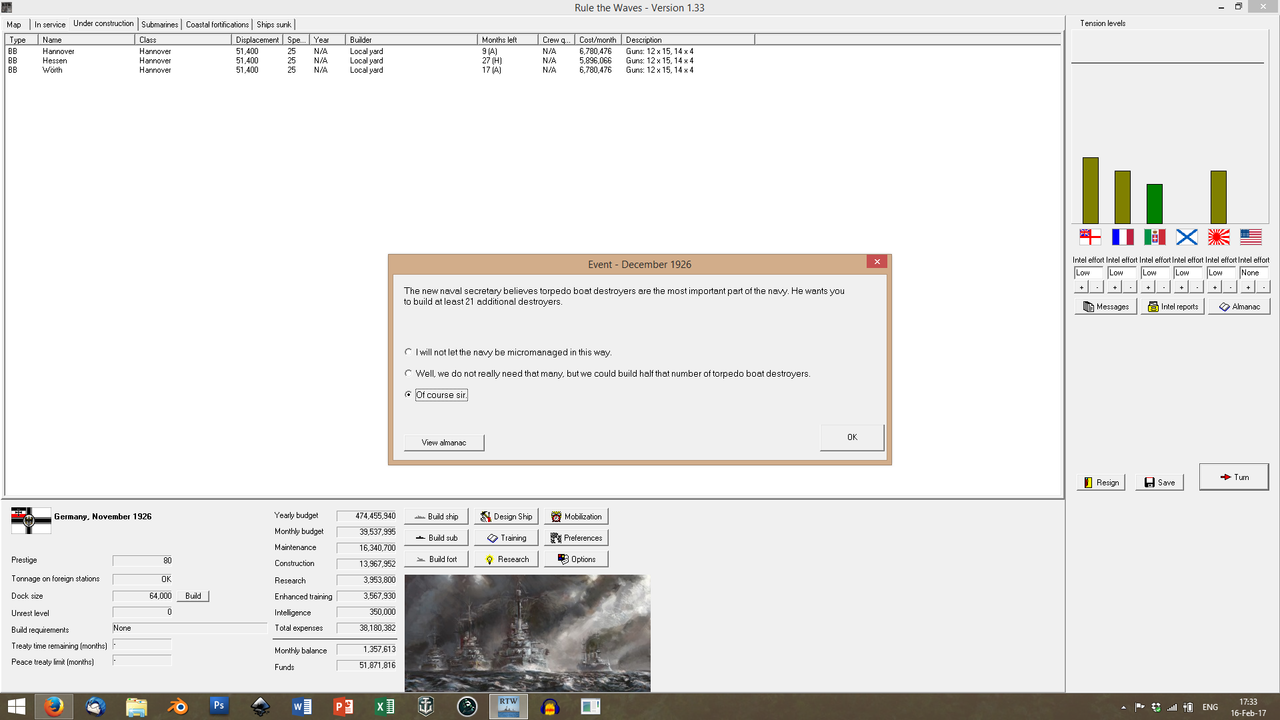
And to hammer the point home, the
Kanzler authorises a major Naval Bill. Twenty-one
Zerstörer of the
G9-class are laid down in November. With this one stroke, Germany once again wrests light force supremacy from her opponents.
Of course, not everybody appreciates this. France, in particular, eyes these new developments with alarm.
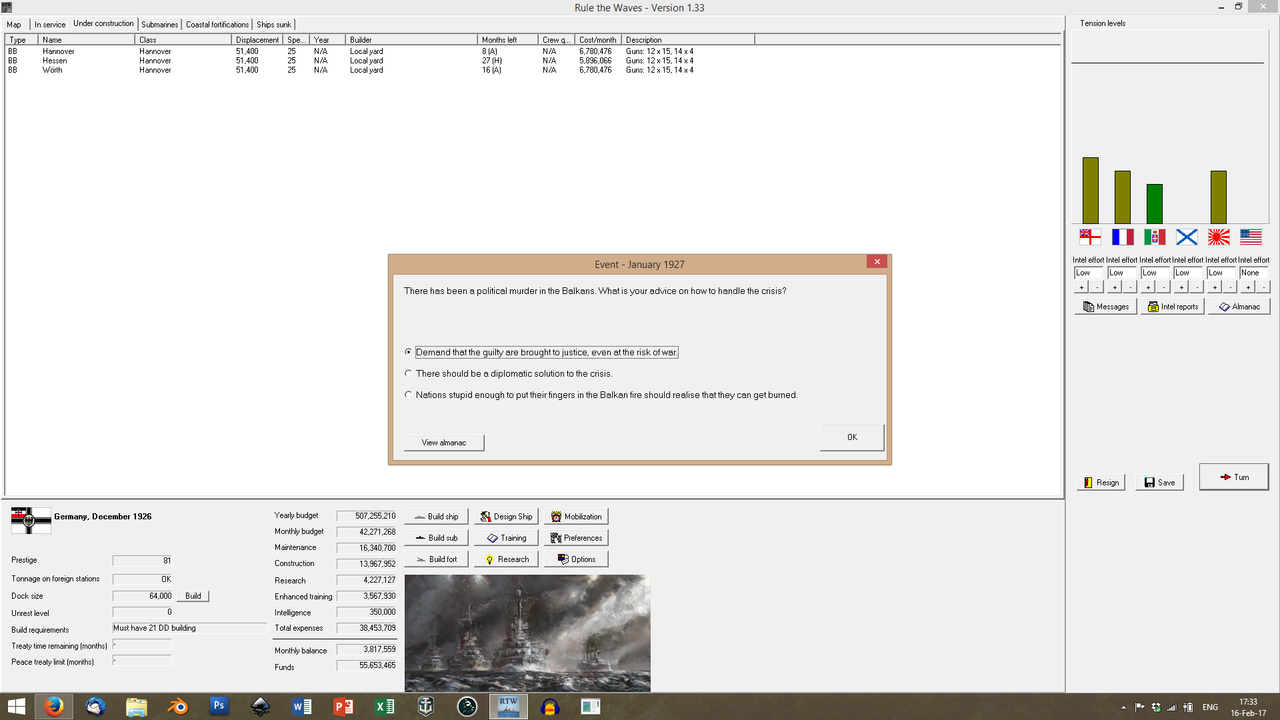
****ING HELL NOT THE BALKANS AGAIN.
Well,
Kerneuropa is the word of the day, and Stresemann wants Austria-Hungary to join the coalition, so it pays to keep them satisfied. Germany fully supports her ally in this most critical of moments.
This alarms France even
more. The ink is still fresh on the Paris Accords, but Germany now seems to seek war again?
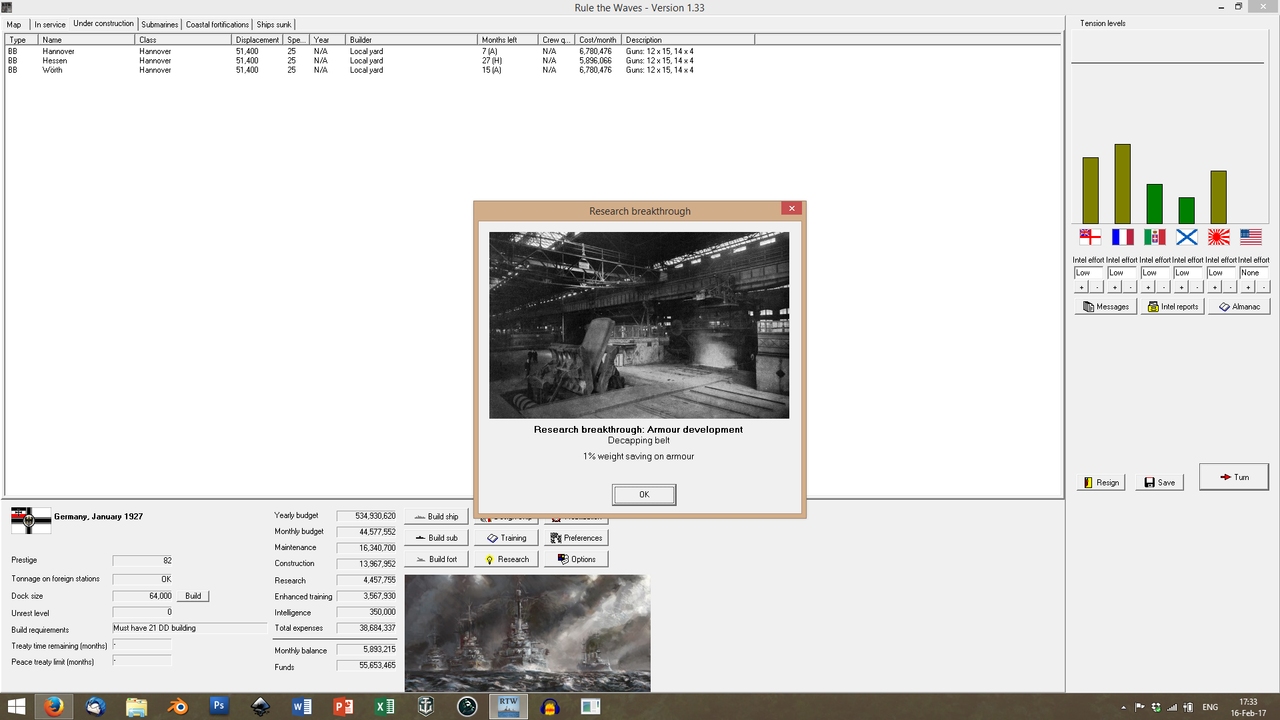
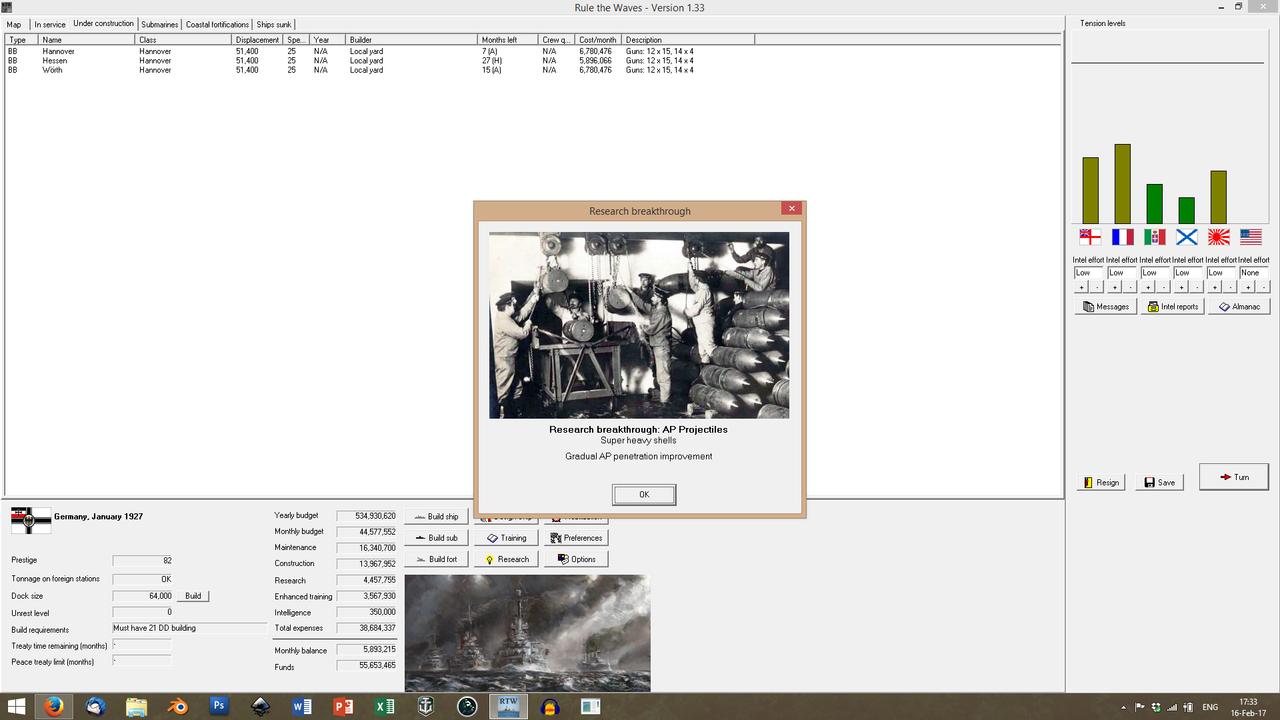
HAH!
HAHAHAH!

Not only a decapping belt, perfectly implemented on the
Hannovers, but also new shells, bigger and punchier than ever before!
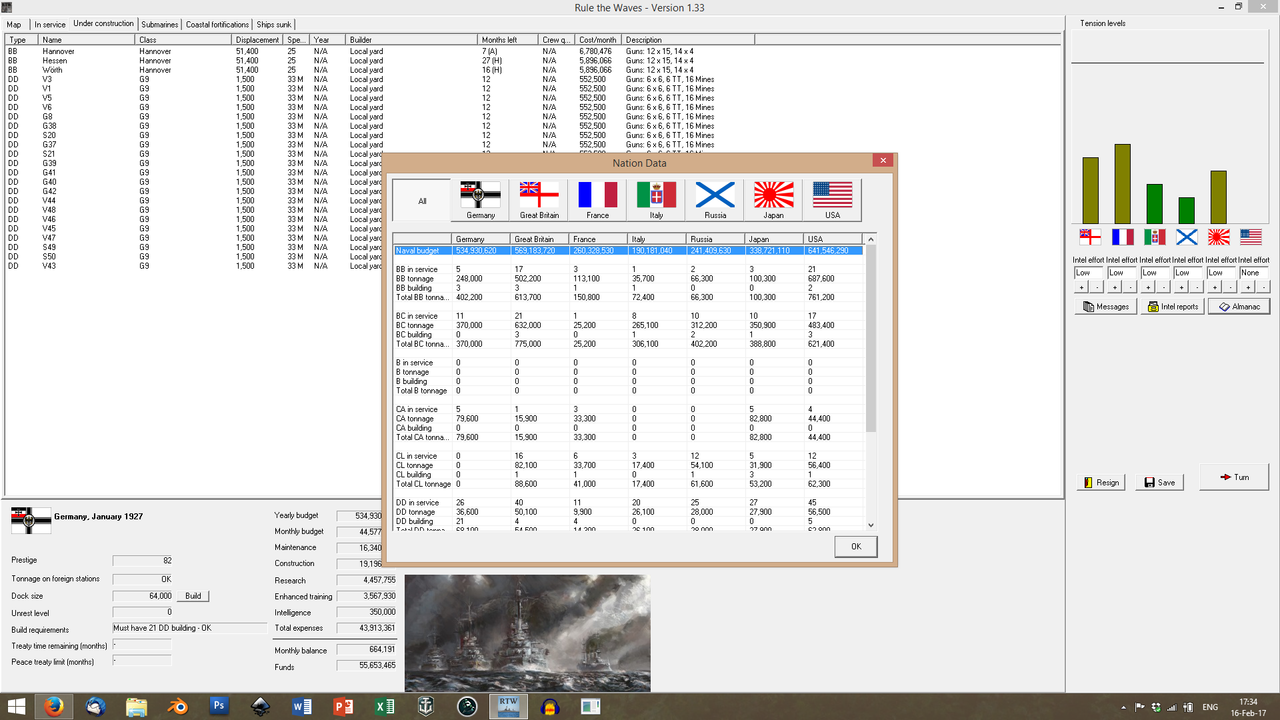

Just look at that budget!
With the new Naval Bill passed, Germany is breathing down Great Britain's neck. The actual tonnages haven't really changed, of course, but Germany is gearing up again!
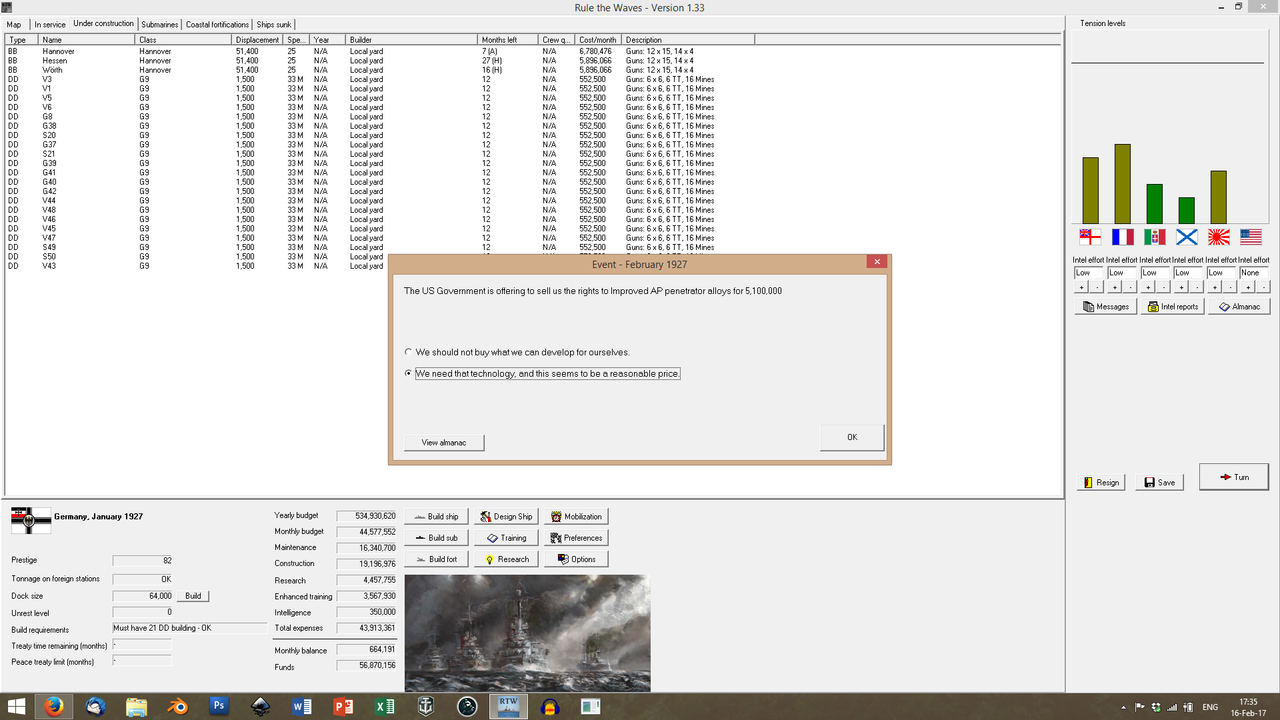
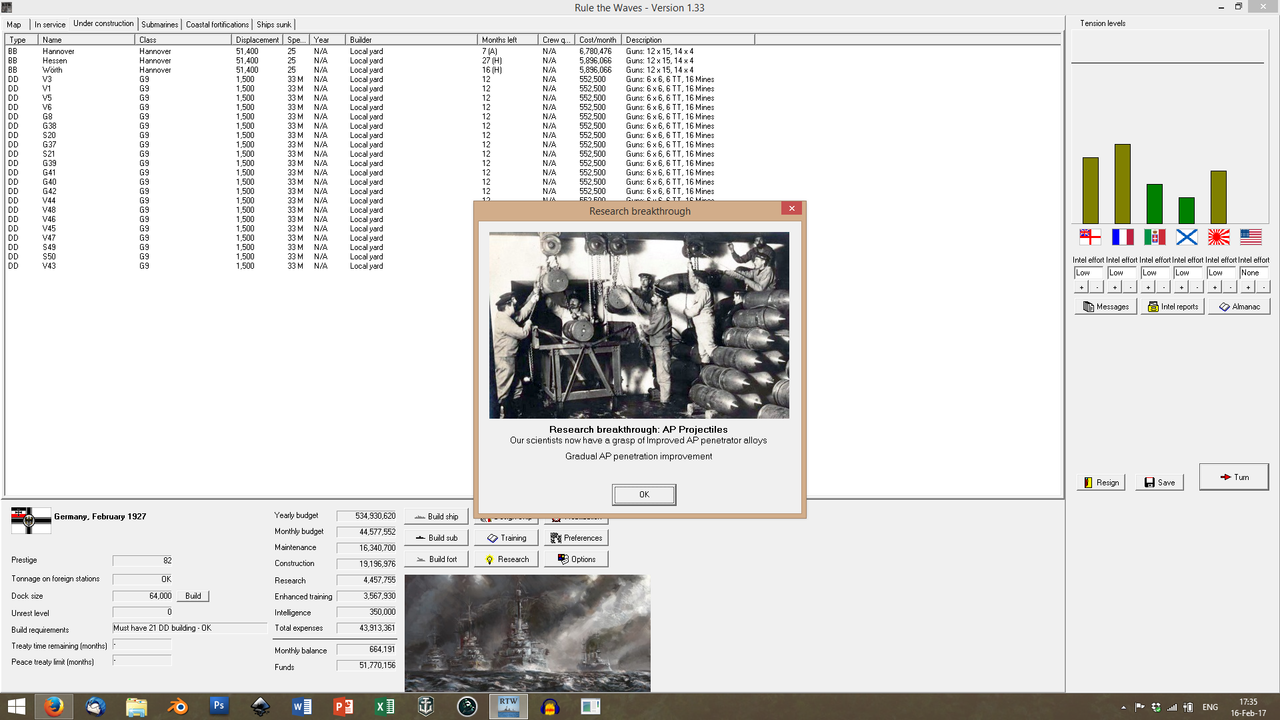
Sure, 'Muricans, make our
huge, fat AP shells
even better! 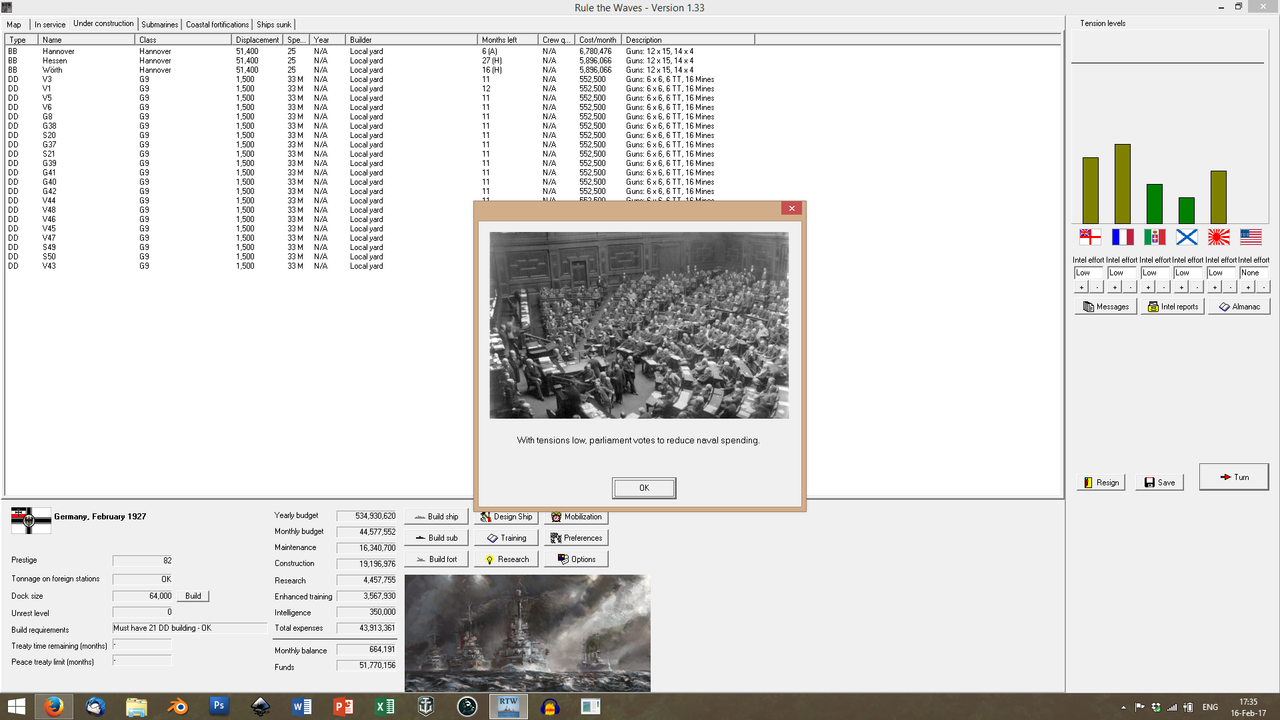

Turns out Germany can't
afford that sort of budget.
Really makes you wonder how the British and the Americans have pulled it off...
(This is called 'foreshadowing')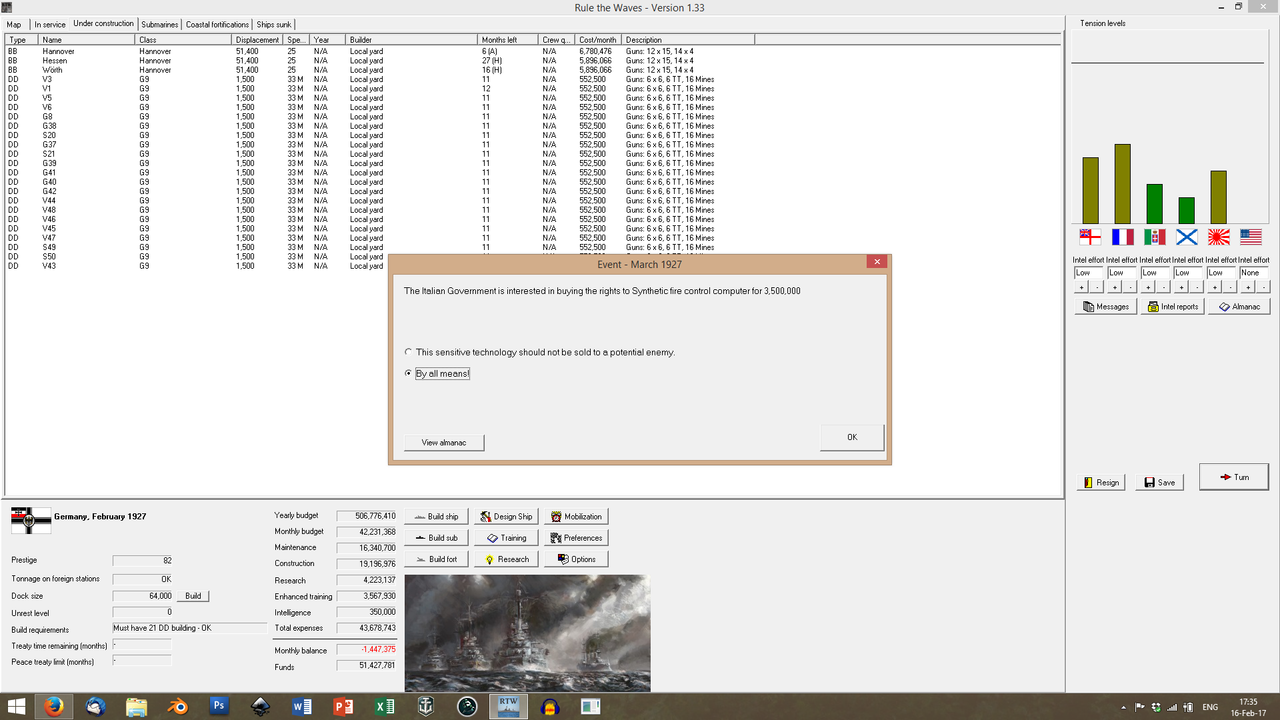
Damn right, you can give us your money! Turns out, we need a lot of it!
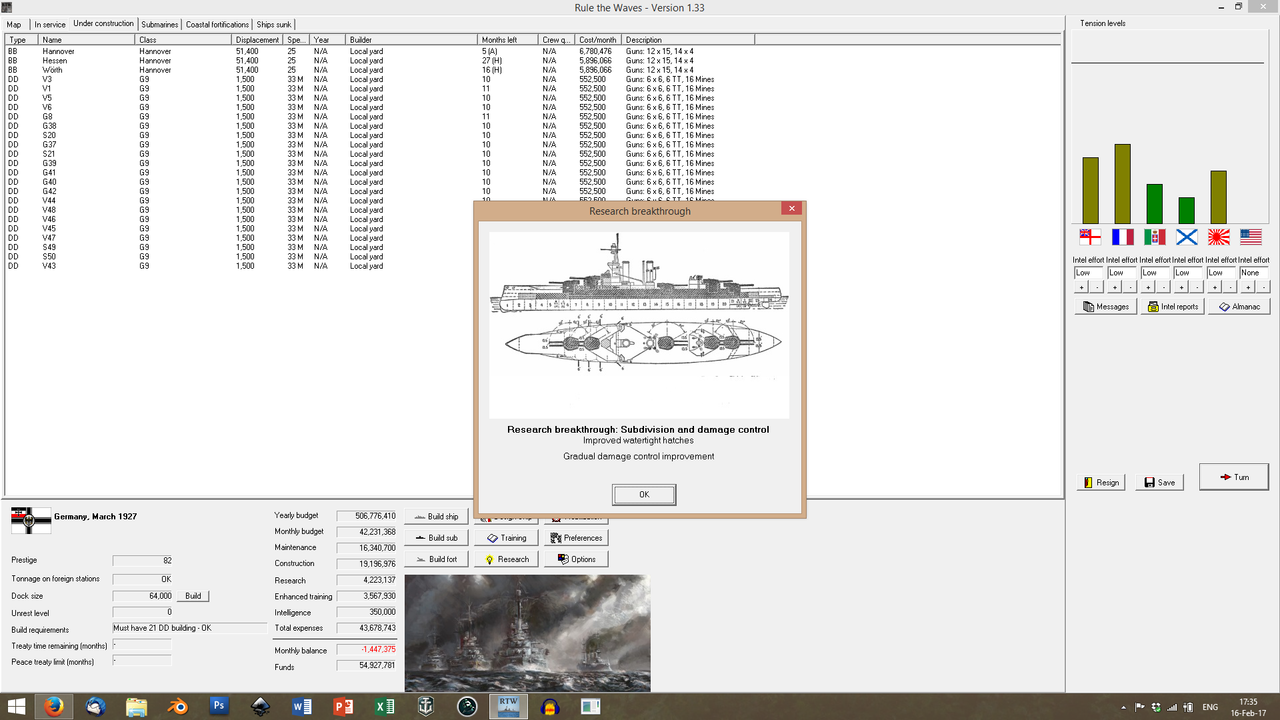
AHAHA, MORE DAMCON!
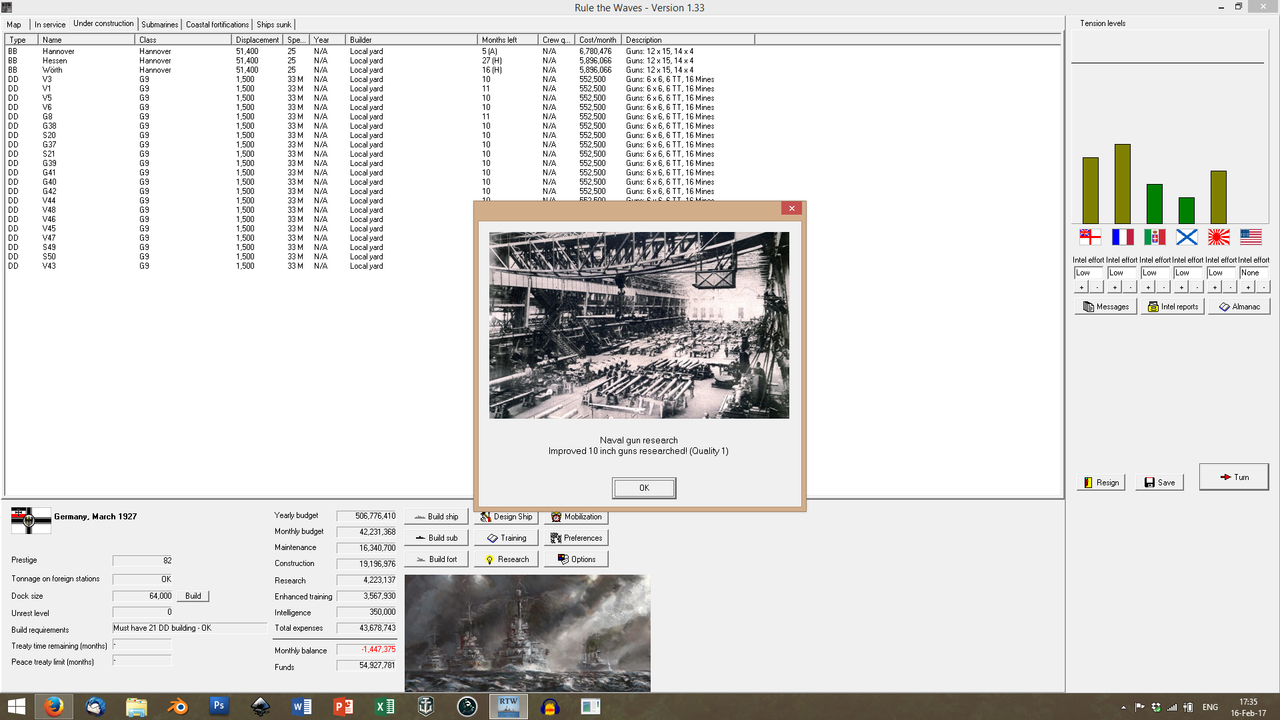
Also this. 10 inch guns are heavy-ish, for a heavy cruiser, though (and, at this point, you can't really use them in anything else).
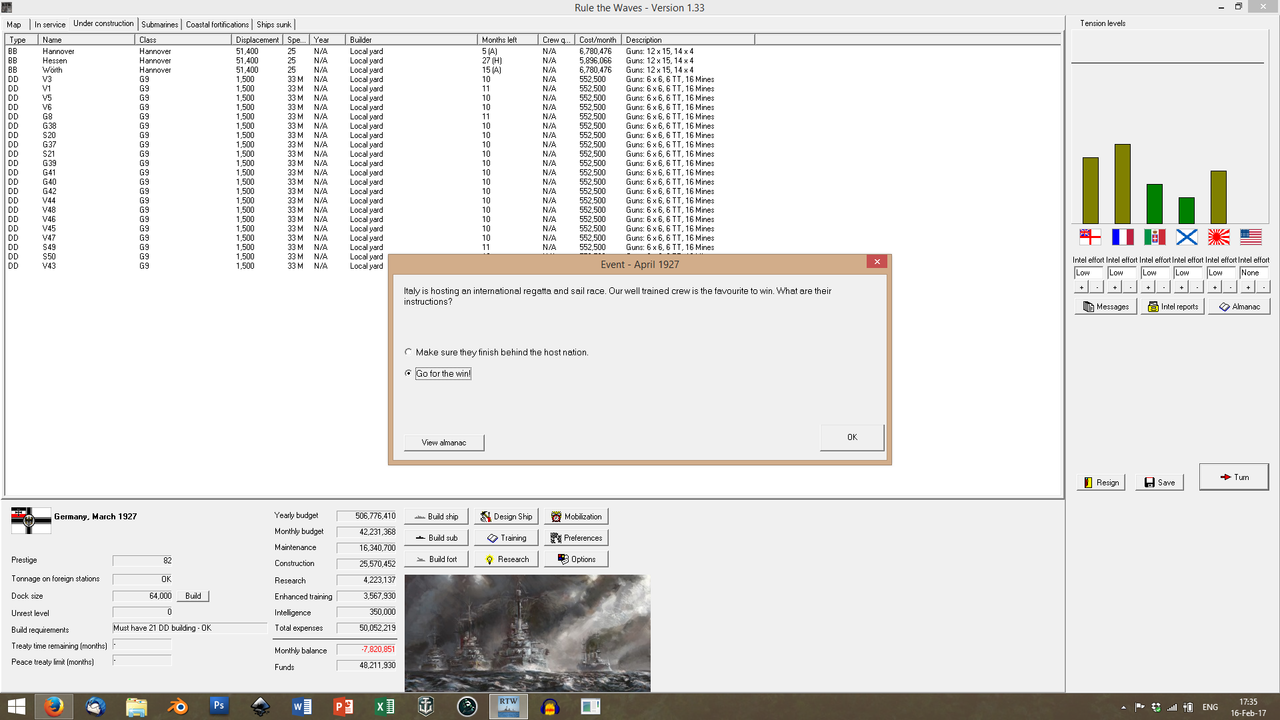
Once again, the Germans utterly dominate in the Messina regatta.
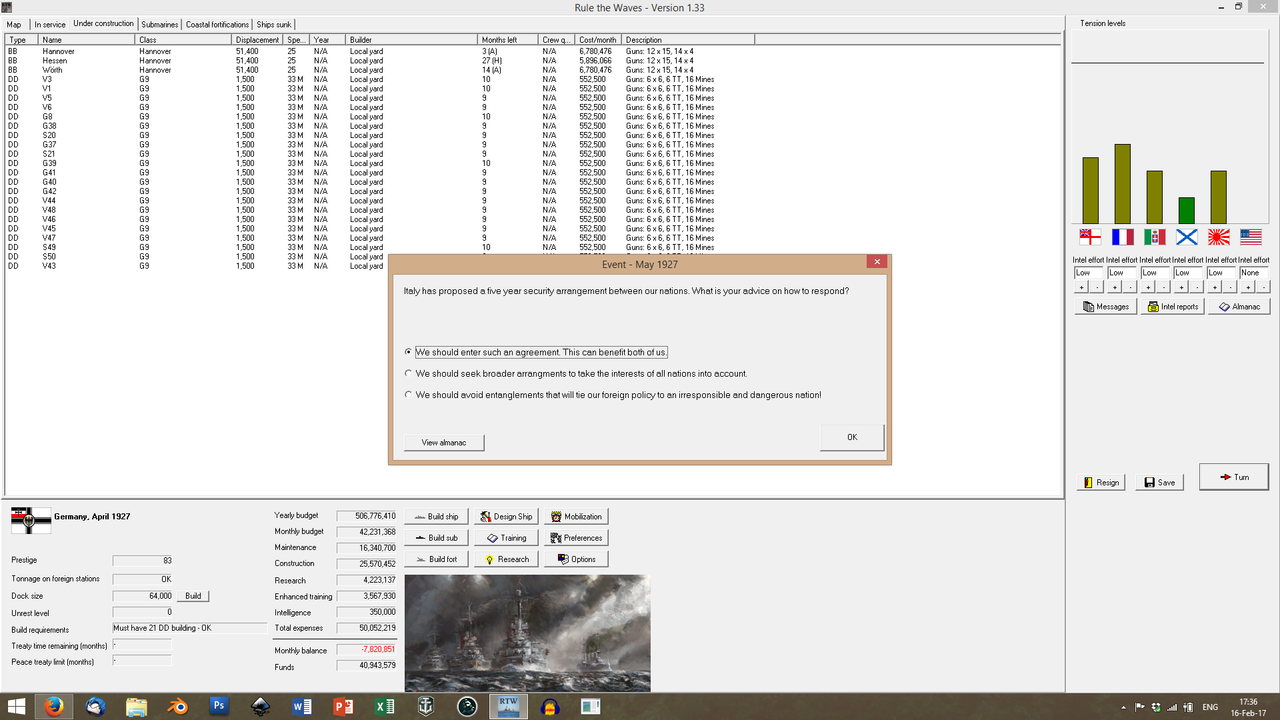
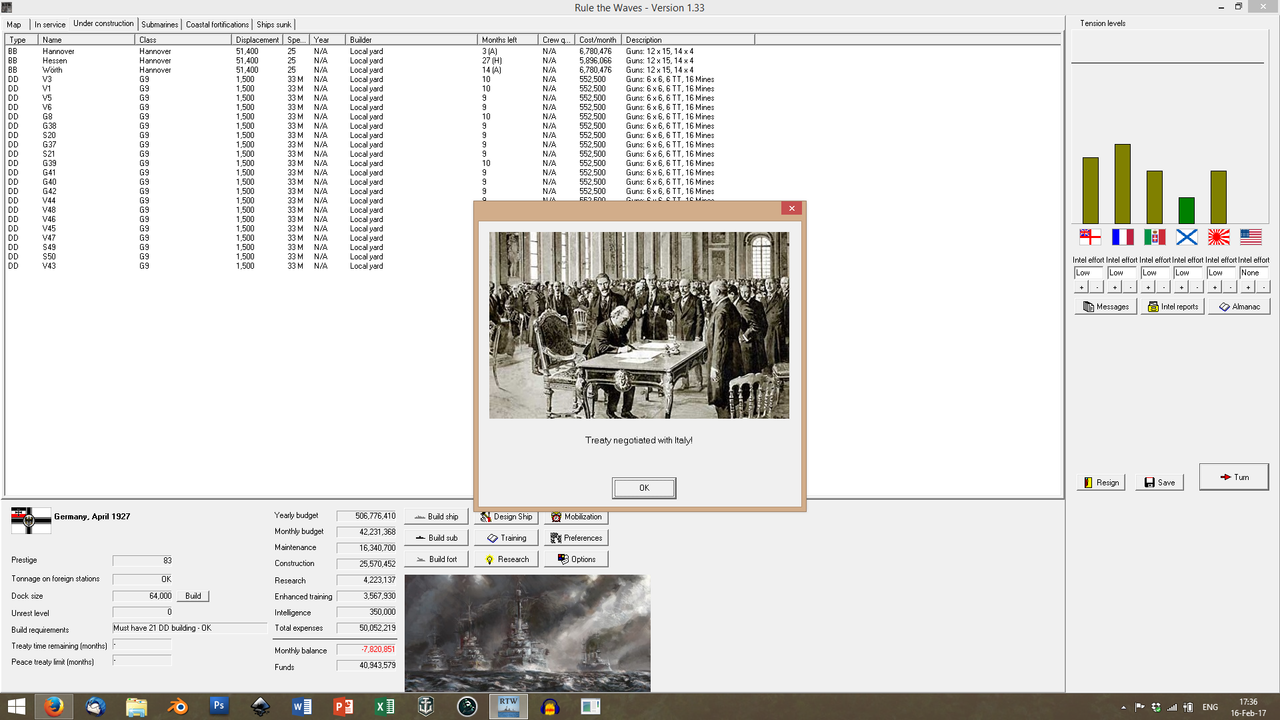
And then, in the aftermath of the regatta, Stresemann and the Italian Prime Minister, Ivanoe Bonomi declare to the world that Italy and Germany are now officially allies in the
Kerneuropa, with the signing of the Treaty of Napoli. For the first time in 20th-century history, Austria-Hungary, Italy, and Germany are part of the same power block. Essentially overnight, the contested Adriatic Sea becomes a
Kerneuropa lake and the Mediterranean now operates completely by
Kerneuropa rules.
This is possibly the most important step towards lasting peace in Europe since the time of Mecklenburg.
And, of course, this makes some people angry.